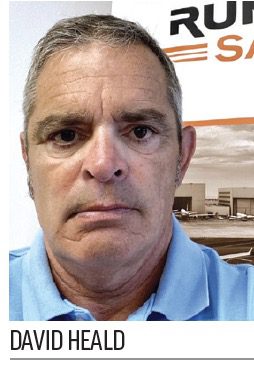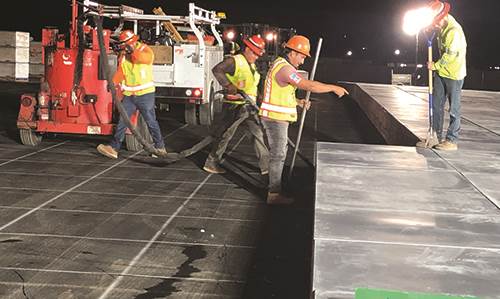SAN was nearing the end of a $10 million project to replace the aging engineered material arresting system (EMAS) at the departures end of its runway with a brand new model. The safety feature is a bed of crushable materials to help stop aircraft overruns. If a plane enters the bed, its tires will sink into the crushable materials to help decelerate the aircraft. The original EMAS was “aging out” right on schedule, and airport officials were thrilled that an aircraft had never entered it.
With a footprint of only 661 acres, San Diego International Airport (SAN) is the busiest single-runway commercial service airport in the United States. As such, management is continually working to improve safety and operational efficiency on Runway 9-27.
In July, SAN was nearing the end of a $10 million project to replace the aging engineered material arresting system (EMAS) at the departures end of its runway with a brand new model. The safety feature is a bed of crushable materials to help stop aircraft overruns. If a plane enters the bed, its tires will sink into the crushable materials to help decelerate the aircraft.
When SAN installed its original EMAS back in 2006, the airport was an early adopter of the then-new technology. The expected lifecycle for the system was roughly 10 years, so SAN began field-testing it in 2015 and received encouraging results from visual inspections and core samples that assessed the material strength of random EMAS blocks. Subsequent testing to monitor the system’s operability occurred in 2017 and 2019, and the final test indicated it was time to move forward with plans for replacement.
|
Project: Engineered Material Arresting System Location: San Diego Int’l Airport Scope: Remove 2006 system, install new version Cost: $10 million Project Start: Feb. 2021 Scheduled Completion: Mid-Sept. 2021 Project Design: Jacobs Engineering System Installed: EMASMAX by Runway Safe Size: 376 ft. long, 200 ft. wide Key Benefits: Enhanced airfield safety |
In short, the original EMAS was “aging out” right on schedule, and airport officials were thrilled that an aircraft had never entered it.
A Lot Has Changed
Product technology and the airport’s traffic have both evolved considerably since SAN installed a first-generation EMAS, notes Airside Operations Manager Dean Robbins.
In 2006, SAN handled about 17.7 million passengers. In 2019, the Southern California airport served more than 25 million travelers and posted its sixth consecutive year of record-breaking passenger totals. Moreover, SAN now accommodates aircraft that didn’t operate there 15 years ago, such as 787s and 777s.
The airport’s new arresting bed is an EMASMAX by Runway Safe, currently the sole manufacturer of EMAS products that meet FAA requirements in Advisory Circular 150-5220-22B. Like its predecessor, the updated bed is a customized cellular concrete block system. But the new EMAS is located closer to the runway and localizer.
Per FAA requirements, SAN’s first aircraft arresting bed had to be installed at least 60 feet away from the runway end because the coating could not withstand jet blast. The new EMASMAX could be located 35 feet from the runway. Placing the bed 25 feet closer to the runway end improves its arresting performance without any damage from jet blast, notes David Heald, regional director at Runway Safe Group. And any space-saving change is welcome news to SAN, given the limited size of its airfield.
Design standards for first-generation EMAS beds also required them to be at least 20 feet from localizer arrays. Now, FAA allows the safety feature within 4 feet of a localizer.
Heald notes that new-generation EMAS like the one SAN installed are stronger, longer, deeper and more capable than their predecessors. Case in point: the EMASMAX is designed for a 20-year lifespan, which matches many pavement life standards. “It’s an improved product,” says Heald.
 Runway Safe also produces greenEMAS, a silica foam system made from recycled glass that is contained within a high-strength plastic mesh. That type of system is anchored to the pavement and covered with a poured cement layer and treated with a topcoat of sealant.
Runway Safe also produces greenEMAS, a silica foam system made from recycled glass that is contained within a high-strength plastic mesh. That type of system is anchored to the pavement and covered with a poured cement layer and treated with a topcoat of sealant.
Typically, EMAS beds span the full width of a runway, but their lengths vary according to runway configuration and fleet mix. The new full-width arresting bed at SAN is 376 feet long—60 feet longer than the previous system.
Project Challenges
As with its first EMAS project, SAN contracted Jacobs Engineering to design the system. Jacobs, in turn, subcontracted Runway Safe to provide arrestment performance modeling. The EMAS manufacturer also provided onsite technical support during installation, under contract with San Diego County Regional Airport Authority.
Construction began in February 2021 and is scheduled to end by Sept. 11 (but was running ahead of pace in mid-July). Because SAN is a single-runway airport, project planning and execution were particularly crucial. While other airports can temporarily shift operations to another runway during construction, Robbins notes that SAN does not have that luxury.
Per FAA standards, runway safety areas should extend 1,000 feet beyond each end of the runway. However, that’s not always possible because of obstacles or lack of available land, as is the case at SAN. Federal regulations also state that standard EMAS should be 600 feet long— yet another challenge for SAN.
 “We’ve got a limited amount of space,” Robbins remarks. “So we really challenged Jacobs Engineering on this project to come up with a design that allows us to maintain EMAS function while we were under construction. That was the biggest challenge.”
“We’ve got a limited amount of space,” Robbins remarks. “So we really challenged Jacobs Engineering on this project to come up with a design that allows us to maintain EMAS function while we were under construction. That was the biggest challenge.”
Because of careful phasing implemented by Jacobs, the project did not require any reduction of runway length. “We collaborated and worked with the FAA to develop a safe approach,” says Robbins. “To me, that was the biggest success coming out of this—working with the FAA and the airlines to make sure that we can do it safely.”
The engineering team considered several options when planning the project and developed a carefully orchestrated three-phase design. “We were especially pleased because it was a very collaborative approach with the FAA,” emphasizes Robbins.
Construction crews began with electrical and infrastructure work, and then transitioned to removing and replacing rows of existing EMAS blocks in two separate phases. This allowed the runway to maintain FAA minimum requirements for declared distance for aircraft.
Christopher Bowker, senior project manager at Jacobs Engineering, explains that crews removed and replaced the front two-thirds of the EMAS at first. “That was the biggest piece of real estate we could give the contractor at a time,” Bowker explains. Crews also needed to make some pavement repairs, including a 1.5-inch mill and overlay, once the EMAS blocks were removed.

Much of the removal and replacement occurred overnight between 12 a.m. and 5 a.m., from Tuesday to Saturday. The construction teams became very efficient working in five-hour windows, reports Robbins. But with mobilization, demobilization and clean up—including sweeping the airfield to meet Part 139 inspection standards every morning—crews typically only had about four hours of time to move the project forward. “That, in and of itself, is a challenge,” he acknowledges.
Although time constraints definitely posed a challenge, Bowker says his team was prepared. “It slows production, but from our past experience, we knew that between midnight and 5 a.m. we could get the project done in an efficient manner,” he remarks.
The bigger challenge was keeping the EMAS functional throughout construction. “If we started demoing the EMAS, we would then need to use declared distance to get the full 1,000-foot safety area,” says Bowker. “That would take away runway length and impact operations.”
So Jacobs phased the project to always maintain at least a 40-knot EMAS. “That allowed us to construct good portions of the project without taking away runway length during construction,” he explains.
While SAN officials had hoped to keep the localizer active throughout the project, it was taken out of service. Because RNAV approaches are now so widely accepted, removal did not pose much of an operational issue for airlines but made construction “significantly easier,” notes Robbins. FAA will recertify SAN’s localizer after the project is complete.
The COVID-19 pandemic posed additional challenges to the entire project team and delayed material delivery. “Trucking went from a week to two weeks,” Heald recalls. Even so, the project remained slightly ahead of schedule. In late June, construction was expected to wrap up by the end of July, with total completion possible in late August.
“This EMAS really helps improve our arrestment performance,” Robbins says. “Once completely installed, we’ll be capable of stopping a 777-300 ER that enters the bed at 59 knots.”
As first-generation arresting systems at other airports reach the end of their service lives, Bowker encourages project teams to learn from the modeling and phasing that occurred at SAN. He also foresees other airports benefiting from improved technology to better accommodate their current fleet mix.
According to FAA records through March 2021, there have been 15 incidents when EMAS have safely stopped overrunning aircraft. None were at SAN.


 facts&figures
facts&figures

